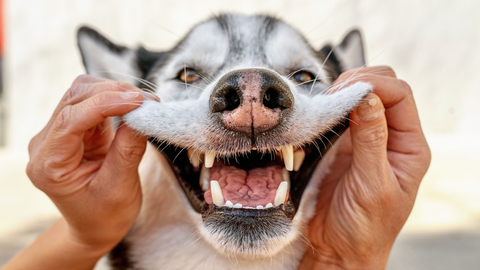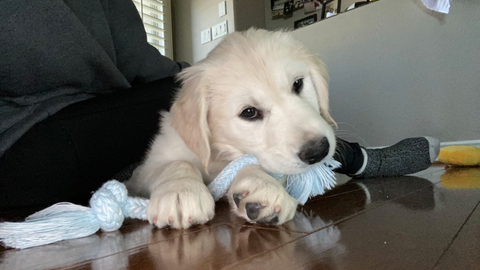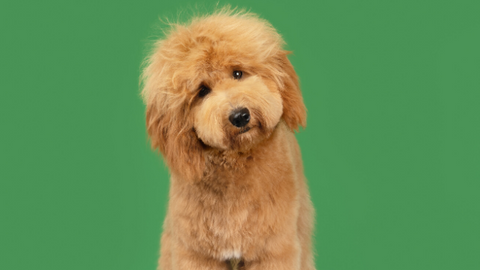Happy February and welcome to the month of love! One of the best ways to show love for your pet is by providing proper care, down to their teeth. The American Veterinary Medical Association declared February as Pet Dental Health Awareness Month to also remind pawrents how important it is to mind your pet’s oral care. As we observe Pet Dental Health Awareness Month, we spoke to pet dental expert, Dr. Thomas of K9 Grillz, about pet dental health and how you can regularly manage it.
K9 Grillz is a Healthy Spot partner that provides non-anesthesic dental cleaning for cats and dogs. Dr. Thomas founded K9 Grillz after observing the gaps and opportunities in the veterinary field when it came to pet oral care and owners that didn’t realize they were missing key steps.

What age should parents start a pet oral routine?
Owners should start to consider dental care for pets as young as 4-9 months of age. Pets in this age range don’t require daily brushing yet, but consistent practicing early on with puppy teeth or kitten teeth will familiarize them with your fingers and hands working in their mouth. This is also good preparation for future brushing and veterinarian-supervised non-anesthetic cat or dog dental cleanings. You can start with softly touching their teeth and gums daily and then move up to a finger brush. Ultimately after the age of 9 months, you will want to brush daily using a soft-bristled small head children’s toothbrush or pet toothbrush with toothpaste specifically made for pets. The key to getting your pet to tolerate brushing is patience, consistency and assertiveness. It is like training them to do anything else. Lots of positive praise and encouragement along the way!Tip: Check out K9 Grillz’ IGTV to learn how to approach brushing for your pet’s size.
What does a good pet oral routine look like and how often should they see a professional?
Once the cat or dog baby teeth fall out and the adult teeth have erupted (varies between 6-9 months of age on average), you should start caring for their teeth just like your own. That consists of daily brushing (or at the very least every other day) and coming in for professional veterinarian-supervised non-anesthetic cleanings between the age of 12-18 months and every 6 months thereafter. Our slogan is "1 ounce of prevention = 1 pound of cure". We want to avoid preventable periodontal disease from developing as opposed to waiting until there is established disease and then treating it. Some periodontal disease is irreversible and can lead to daily discomfort or severe pain, loss of teeth or the need for expensive surgical extraction, and possibly even severe secondary systemic disease which can lead to potentially shortened life spans. I always try to impress upon my clients that we want their pets' teeth to look as clean, white, and plaque/tartar free as our own teeth for all the exact same health reasons. We would never wait until there was heavy, discolored plaque and tartar on our teeth to visit the dentist, so why would we wait for it to develop on our pets’ teeth?
What should pet parents look out for as they maintain their pet’s oral care?
The goal is to keep their teeth as clean and white as our own at all times. You have to look in their mouths and brush their teeth daily to know what looks normal and what looks abnormal.Some things to look out for are red, swollen, actively bleeding gums. You may sense they are experiencing pain or discomfort when you try to handle their mouths. They may also show signs of aggression. Bad odor, heavy discolored buildup, debris/hair accumulation between teeth, loose teeth, gum loss, foreign bodies (i.e. twigs, string etc) are all things to watch out for in order to prevent preventable disease.
What are common mistakes that pet parents make when it comes to oral care and how can they be avoided?
The most common mistake is not implementing any care at all and waiting until there is heavy build up and/or severe disease onset in a pet’s mouth to address dental care. Again, periodontal disease is just as preventable in our pets mouths as it is in our own. There’s a commonly quoted statistic from the American Veterinary Medical Association that says something to the effect of, “70-80% of dogs/cats have some degree of periodontal disease by the age of 3.” In my experience, I’ve seen this disease present in pets as early as the age of 2 and feel there’s a very critical word missing from that statistic: “preventable.” What this repeated mistake boils down to is neglect despite many parents not realizing they’re making a mistake in the first place. The good news is that you can start to correct this now! If you’re local to a Healthy Spot store, come see K9 Grillz and we will let you know the status of your pets oral health. If we can get your pet’s oral health on track, we will. If your pet requires the next level of medical intervention and anesthesia first, we will direct you there. Regardless, we can and will get ahead of it together.Tip: If you aren’t nearby, send an Instagram message with any questions you may have to help find the best solution in your area.

What kind of service can one expect from K9 Grillz? What process does a pet go through for oral care?
Your pet's dental appointment with K9 Grillz would consist of an oral and physical wellness exam by a licensed veterinarian to determine if non-anesthetic dental prophylaxis is a suitable option or whether anesthetic intervention is necessary first. If, on physical and oral exams, there are no significant structural or infectious abnormalities identified and he/she is comfortable and compliant (we do not force any animal through this procedure), the dental cleaning would ensue. All the same dental instrumentation including hand dental instruments, ultrasonic scalers and mechanical polishers are employed just as we would under general anesthesia. The K9 Grillz cleaning method and depth is the exact same as it would be for an anesthetized animal in a hospital setting. We are able to gain the exact same access to the oral cavity in compliant animals. Animals that require anesthetic intervention for extraction or x-rays first are generally encouraged to return to see us again 4-6 months after anesthesia for re-evaluation for admittance into our maintenance program moving forward. If your pet requires anesthetic intervention, we refer you back to your regular veterinarian. You will be provided with a detailed dental chart of our findings, any abnormalities and any areas to watch closely over time. Lastly, you will be sent home with home care instructions and a K9 Grillz toothbrush!
What products do you suggest to use for pet oral care?
Above ALL else, we advocate daily brushing and routine, consistent cleanings. Any of the sprays, gels, water additives are possibly beneficial secondarily, but there is no substitute for brushing. 
As you delve deeper into all things dental when it comes to your pet, learn more about K9 Grillz at k9grillz.com or on their Instagram, @k9grillz. You can also check out last September’s Tooth Talk event on our IGTV and RSVP to our upcoming Woof From Home event, Tooth Trivia hosted by Dr. Thomas on February 11. Interested in booking an appointment with K9 Grillz for your pet? Call your local Spot to book today!



Comments (0)
There are no comments for this article. Be the first one to leave a message!